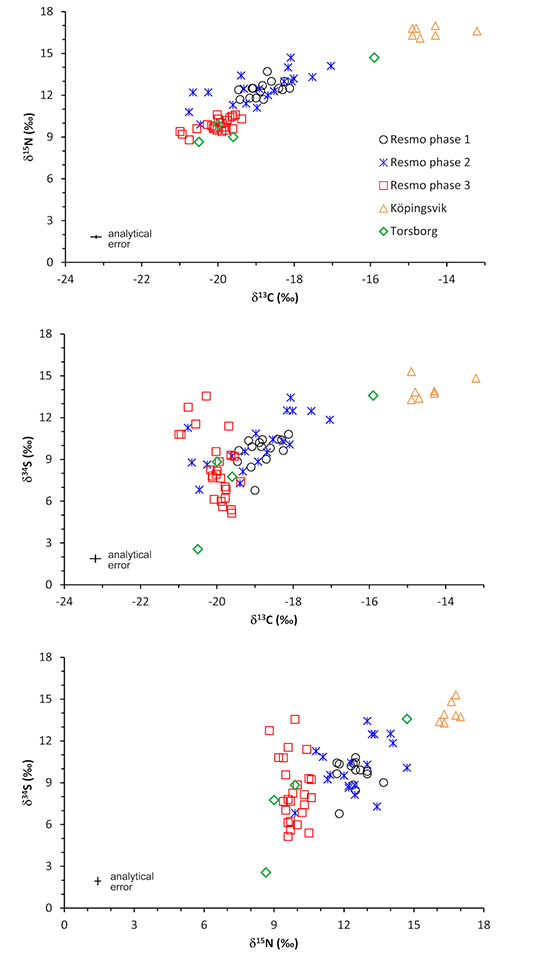
Observed δ34S values for the human samples are presented in Table 3 and Figure 3. The 70 samples derive from 36 individuals, and include intra-individual data for 22 of these individuals.

The δ34S values for six Middle Neolithic individuals from Köpingsvik range from +13.3 to +15.3‰ (+14.0 ± 0.7‰, n=7), very similar to the range for marine mammals, and consistent with a diet of predominantly marine mammal protein. The only intra-individual data, for Grave Klinta A7, demonstrate no change in δ34S from childhood to adult age.
Stable sulphur isotope data for the four individuals from Torsborg (one sample each) range from +2.6‰ to +13.6‰. The Middle Neolithic individual, the only one with a carbon isotope value indicating any substantial consumption of marine protein, has the highest value, +13.6‰, comparable to values for Pitted Ware Köpingsvik. The Late Neolithic individual has a considerably lower value, +8.8‰, whereas the two Bronze Age individuals have even lower values of +2.6‰ and +7.8‰, respectively.
Observed δ34S data for the Resmo individuals show a distinct chronological pattern, with increasing ranges for each phase. Eight individuals in Phase 1 (Early/Middle Neolithic) range from +6.8 to +10.8‰ (+9.6 ± 1.0‰, n=15), ten individuals from Phase 2 (Middle/Late Neolithic) range from +6.8 to +13.4‰ (+10.1 ± 1.9‰, n=19), and ten individuals from Phase 3 range from +5.1 to +13.6‰ (+8.4 ± 2.3‰, n=25). The implications of the Resmo data will be discussed in detail below.
Internet Archaeology is an open access journal based in the Department of Archaeology, University of York. Except where otherwise noted, content from this work may be used under the terms of the Creative Commons Attribution 3.0 (CC BY) Unported licence, which permits unrestricted use, distribution, and reproduction in any medium, provided that attribution to the author(s), the title of the work, the Internet Archaeology journal and the relevant URL/DOI are given.
Terms and Conditions | Legal Statements | Privacy Policy | Cookies Policy | Citing Internet Archaeology
Internet Archaeology content is preserved for the long term with the Archaeology Data Service. Help sustain and support open access publication by donating to our Open Access Archaeology Fund.
File last updated: Thu Nov 13 2014